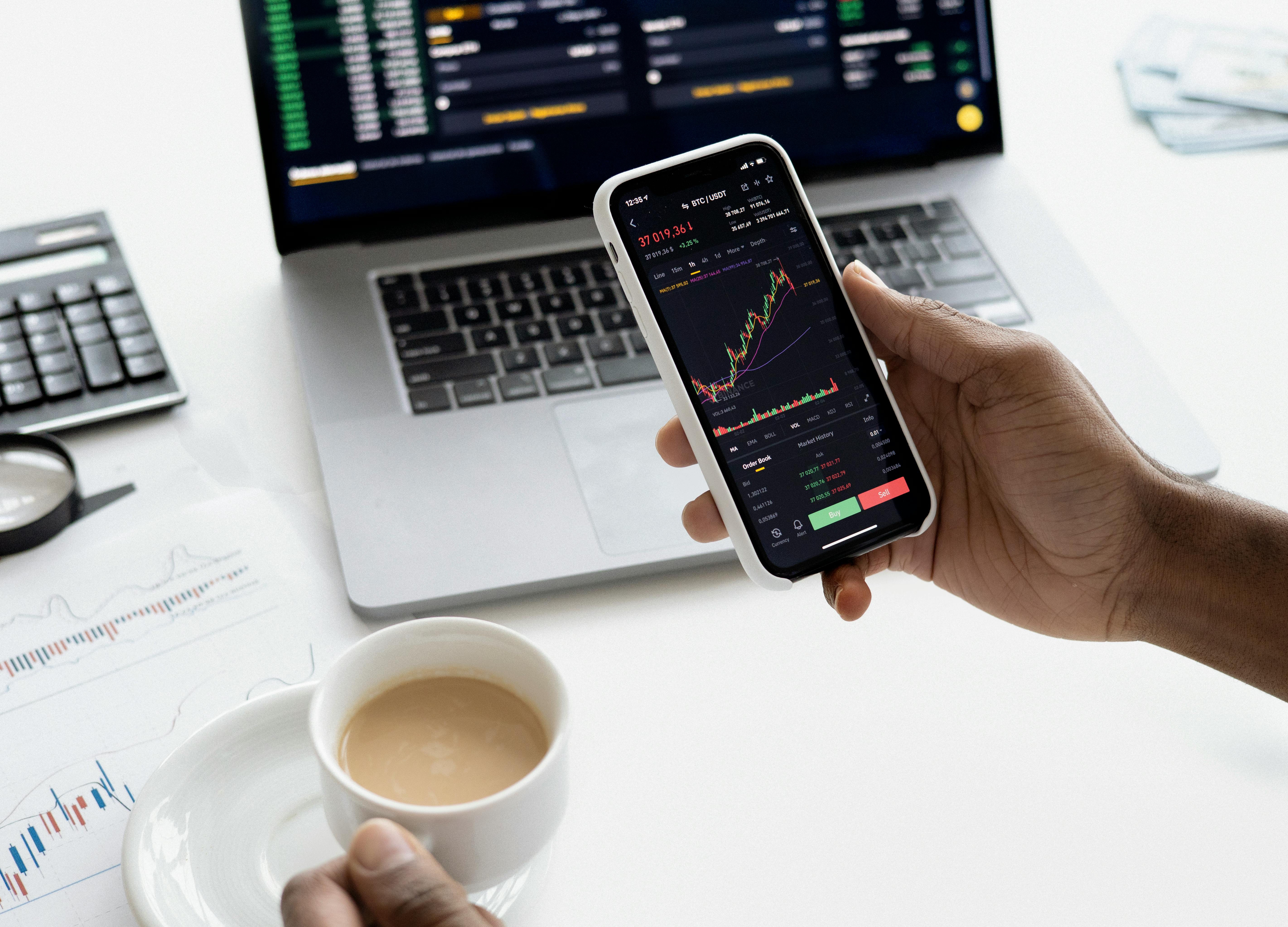Products
Trading Strategies
Markets
Ask AI About SPGI

No Data Yet

## S&P Global Launches Hybrid Digital Markets 50 Index, Signaling Strategic Evolution U.S. financial services giant **S&P Global** (NYSE: **SPGI**) announced the launch of the **S&P Digital Markets 50 Index** on October 7, 2025. This new benchmark, developed in collaboration with tokenization firm **Dinari**, represents a notable development in the financial industry, combining traditional equities with digital assets in a single, rules-based structure. The index's introduction arrives amidst a surging year for crypto-linked assets, indicating a strategic move by S&P Global to cater to evolving market demands and integrate digital assets further into mainstream investment products. ## The S&P Digital Markets 50: A Detailed Overview The **S&P Digital Markets 50 Index** is designed to provide investors with a balanced exposure to the rapidly expanding digital economy. It is comprised of two primary components: 15 major cryptocurrencies, including **Bitcoin**, **Ethereum**, **Cardano**, and **Polkadot**, and 35 publicly traded companies. These equities include firms such as **Coinbase**, **Nvidia**, and **Strategy** (formerly MicroStrategy), selected for their substantial involvement in blockchain technologies, crypto reserves, or hardware solutions supporting crypto mining and AI computation. The index employs a market capitalization-weighted structure with strict inclusion rules to ensure diversification and transparency. Constituent cryptocurrencies must possess a minimum market capitalization of **$300 million**, while equities require a minimum of **$100 million**. Critically, no single asset is permitted to exceed a **5% weighting** within the index. The benchmark is subject to quarterly rebalancing to reflect dynamic market conditions and asset performance. Dinari plans to make tokenized shares tracking the index accessible via its dShares platform by year-end 2025, facilitating 24/7 trading. ## Market Reception and Analytical Insights The introduction of the **S&P Digital Markets 50 Index** is largely viewed as a significant step towards the institutional adoption of cryptocurrencies. Financial analysts interpret this as a validation of crypto as a legitimate asset class, offering a more structured and potentially less volatile avenue for exposure compared to direct crypto holdings. The timing of the launch aligns with a period of strong performance in crypto-linked assets, with **Coinbase** stock rising over **50%** and **Robinhood** rallying **250%** in 2025 following expanded digital offerings. Bitcoin also recently achieved a new record high. This hybrid index structure, with its **70% equity allocation** and quarterly rebalancing, is designed to mitigate the inherent volatility associated with direct cryptocurrency exposure while still capturing innovation-driven growth in the sector. This approach is particularly appealing to institutional investors seeking diversification without full commitment to less regulated markets. ## Broader Context and Implications The establishment of this index follows a series of regulatory advancements that have created a "regulatory on-ramp" for institutional investors. Key among these are **Executive Order 14178**, signed in April 2025, which established the Presidential Working Group on Digital Asset Markets, and the **GENIUS Act** of July 2025, providing a comprehensive framework for stablecoins. These developments have collectively reduced legal and compliance uncertainties that historically deterred institutional engagement with digital assets. The tokenization aspect, facilitated by **Dinari**, allows investors in over 70 countries to access the index without reliance on traditional brokers. This setup supports fractional ownership, faster settlement, and seamless integration with existing custody and fund administration systems, potentially drawing billions in new liquidity into the market. For **S&P Global**, this initiative could significantly enhance its long-term market position by diversifying its offerings and tapping into new revenue streams from the growing digital asset market. ## Expert Perspectives **Cameron Drinkwater**, Chief Product Officer at S&P Dow Jones Indices, articulated the market's evolution, stating: > "Cryptocurrencies and the broader digital asset industry have moved from the margins into a more established role in global markets. Our expanded index suite offers market participants consistent, rules-based tools to evaluate and gain exposure to this segment." **Gabriel Otte**, CEO of Dinari, emphasized the bridging function of the new product: > "Our mission at Dinari is to help set a standard for how tokenized equities can safely and compliantly enhance traditional finance. The S&P Digital Markets 50 shows how established benchmarks can be extended onchain, giving customers both the transparency of tokenization and the control of direct indexing." These commentaries underscore the industry's recognition of digital assets as an increasingly integral part of the global financial landscape. ## Looking Ahead The launch of the **S&P Digital Markets 50 Index** is expected to catalyze further institutional investment and the development of new financial products, such as **ETFs**, **mutual funds**, and derivatives, tied to the index. The focus will be on how quickly and effectively **S&P Global** and **Dinari** can onboard institutional clients and whether the index can maintain its appeal amidst continued market volatility. However, **S&P Global** faces internal dynamics that warrant attention. The departure of Chief Digital Solutions Officer Swamy Kocherlakota, noted as a potential execution risk for the firm's digital and AI initiatives, highlights the importance of leadership continuity in this evolving space. While the immediate financial impact on **SPGI** may be limited, the long-term success of this strategic shift will depend on effective execution and the firm's ability to navigate leadership transitions to sustain its digital innovation momentum.

## Market Event Overview **Reynolds Consumer Products Inc.** (NASD: REYN) is set to replace **SpartanNash Co.** (NASD: SPTN) in the **S&P SmallCap 600** index, with the change effective prior to the open of trading on Wednesday, September 24, 2025. This rebalancing action by **S&P Dow Jones Indices**, a division of **S&P Global** (NYSE: SPGI), follows the pending acquisition of SpartanNash Co. by **C&S Wholesale Grocers LLC**. Both Reynolds Consumer Products, recognized for household brands such as Reynolds Wrap and Hefty, and SpartanNash operate within the **Consumer Staples** sector. ## Details of Index Rebalancing The inclusion of **Reynolds Consumer Products** in the S&P SmallCap 600 index marks a significant development for the company. Historically, such additions lead to increased demand for the company's shares as index funds and exchange-traded funds (ETFs) tracking the S&P SmallCap 600 are mandated to purchase the stock to accurately reflect the benchmark. This "forced buying" typically generates positive price pressure during the implementation period and can enhance trading liquidity, potentially narrowing the stock's bid-ask spread. Following the announcement on September 19, 2025, **REYN** shares advanced 5.3% in after-hours trading, indicating immediate investor interest. Inclusion in the S&P SmallCap 600 signifies that **Reynolds Consumer Products** meets stringent financial viability criteria established by S&P Dow Jones Indices. These requirements include a market capitalization between $1.2 billion and $8 billion, robust liquidity, and consistent financial stability, specifically positive as-reported earnings over the most recent quarter and the preceding four quarters. ## Implications for Reynolds Consumer Products The index inclusion is anticipated to significantly boost **Reynolds Consumer Products'** visibility among both institutional and retail investors. Analysts project institutional ownership of **REYN** to increase by 5–10% within six months as passive funds rebalance their portfolios. From a business strategy perspective, this inclusion is expected to stabilize **REYN's** stock liquidity and mitigate the risk of underperformance relative to its peers. **Reynolds Consumer Products** has demonstrated disciplined financial management, evidenced by a current ratio of 1.85 and $489 million in operating cash flow for 2024. These metrics position the company favorably to capitalize on the anticipated influx of capital. Furthermore, **REYN's** valuation metrics, including a forward Price-to-Earnings (P/E) ratio of 14.19 and an Enterprise Value-to-EBITDA (EV/EBITDA) of 10.88 as of September 2025, appear undervalued compared to the S&P SmallCap 600's 12-month averages of 16.5 and 13.2, respectively. This suggests the company is well-positioned for potential outperformance in a stable interest rate environment. ## Impact on SpartanNash Co. **SpartanNash Co.** will be removed from the S&P SmallCap 600 due to its pending acquisition by **C&S Wholesale Grocers LLC**. The merger agreement stipulates that C&S Wholesale Grocers will acquire SpartanNash for a purchase price of $26.90 per share in cash, representing a total consideration of $1.77 billion, including assumed net debt. This transaction, unanimously approved by both companies' Boards of Directors, signifies SpartanNash's transition to a privately held entity. The acquisition has progressed through key regulatory hurdles, with the 30-day waiting period under the Hart-Scott-Rodino Antitrust Improvements Act expiring without action by the U.S. Federal Trade Commission. SpartanNash expects the transaction to close on or about September 22, 2025, subject to customary closing conditions. ## Broader Market Context and Outlook The strategic shift involving **Reynolds Consumer Products** and **SpartanNash Co.** highlights the profound impact of index actions on demand and short-term price movements for smaller U.S. companies. The rebalancing reflects the dynamic nature of market indices, which are continuously influenced by corporate actions such as mergers and acquisitions. This event also underscores ongoing consolidation within the **Consumer Staples** sector, a trend that can reshape competitive landscapes. Investors will closely monitor **Reynolds Consumer Products'** ability to maintain its financial discipline and leverage its heightened market visibility to drive sustained shareholder value. The immediate market reaction to the announcement reaffirms the importance of index inclusion as a catalyst for liquidity improvements and investor sentiment in the small-cap segment. The future performance of **REYN** will offer insights into the long-term benefits of such strategic index placements.

## S&P Global Ratings Upgrades Diebold Nixdorf Credit Amidst Stock Decline **S&P Global Ratings** announced an upgrade to **Diebold Nixdorf's** (NYSE: DBD) credit rating, moving it to 'B+' from 'B' with a stable outlook on September 18, 2025. This positive development, typically indicative of reduced financial risk and improved solvency, was met with a contradictory market reaction, as the company's shares experienced a 5.26% decline on the day the news was released. ## The Event in Detail The upgrade reflects **Diebold Nixdorf's** strengthened financial profile, solid cash flow generation, and improving debt leverage ratios. **S&P** cited the company's focus on cost reduction efforts and working capital efficiencies as key drivers supporting continued EBITDA and free operating cash flow (FOCF) expansion. The rating agency highlighted that **Diebold** generated approximately $138 million of adjusted annual FOCF in 2024 and has maintained positive FOCF for three consecutive quarters, including the first half of 2025. Looking ahead, **S&P** anticipates **Diebold** will generate annual FOCF exceeding $200 million starting in 2025. ## Analysis of Market Reaction The market's immediate negative response to the credit upgrade signals a complex investor sentiment. Typically, a credit rating upgrade is viewed favorably, suggesting reduced borrowing costs and enhanced financial flexibility, which should theoretically boost investor confidence. The 5.26% retreat in **DBD** stock, however, indicates that other factors may be weighing on market participants. This could be interpreted as a "sell the news" event, where positive developments are already priced into the stock, and investors opt to take profits. Alternatively, it might reflect underlying skepticism regarding the sustainability of **Diebold Nixdorf's** operational improvements or broader concerns about the maturity of its core ATM market, outweighing the credit enhancement. ## Broader Context and Implications The upgrade is underpinned by a significant projected improvement in **Diebold Nixdorf's** financial metrics. **S&P** forecasts the company's leverage to decrease substantially from 5.1x debt/EBITDA at the end of 2023 to approximately 2.7x by the end of 2025, with further deleveraging to the low-2x level expected in 2026. Adjusted EBITDA is projected to reach about $409 million in 2025, increasing to $514 million in 2026. These improvements are supported by a $165 million cost restructuring program set to conclude this year, which management expects to contribute 125-150 basis points in annual gross margin improvement and $50 million in operating expense savings through 2027. Strategically, while **S&P** acknowledges the ATM market as mature with limited growth prospects, it believes **Diebold** can maintain steady performance. The retail sector is expected to become a larger contributor to top-line growth in 2026, driven by a broad end-market recovery, expansion in European markets, and greater penetration in North America. **Diebold Nixdorf** is also pivoting towards software and cloud-based solutions and expanding into Asia-Pacific and Latin America, aiming to diversify revenue and generate an additional $150 million in new regional revenue. The company maintains a large and growing backlog of $980 million as of the second quarter of 2025. Furthermore, **Diebold Nixdorf** announced a $100 million share repurchase authorization in February 2025, having already repurchased roughly $40 million of common stock through the first half of the year, signaling confidence in its intrinsic value. ## Expert Commentary Analysts emphasize the strategic importance of the upgrade. As noted by AInvest, > "The upgrade marks a pivotal moment in the company's strategic transformation, aligning its financial profile with long-term growth objectives, though investors and analysts are closely watching to determine if these improvements represent sustainable operational execution or a temporary rebound." **S&P's** stable outlook, despite inherent risks from cashless trends and existing debt, further underscores their confidence in **Diebold Nixdorf's** sustainable growth strategy. ## Looking Ahead Looking forward, **S&P** forecasts somewhat flat revenue for **Diebold Nixdorf** in 2025, followed by slowly ramping low- to mid-single-digit percent growth in 2026 and 2027. The company's robust backlog and ongoing strategic initiatives, particularly in the retail sector and software solutions, are expected to be crucial for sustaining momentum. Investors will likely monitor future earnings reports, particularly regarding free cash flow generation and continued deleveraging, to assess whether the financial improvements translate into consistent operational execution and a positive shift in market perception. The interplay between fundamental financial strength and market sentiment will define **DBD's** trajectory in the coming quarters.
The P/E ratio of S&P Global Inc is 38.5271
Ms. Martina Cheung is the President of S&P Global Inc, joining the firm since 2015.
The current price of SPGI is $477.6, it has increased 0% in the last trading day.
S&P Global Inc belongs to Financial Services industry and the sector is Financials
S&P Global Inc's current market cap is $145.8B
According to wall street analysts, 24 analysts have made analyst ratings for S&P Global Inc, including 11 strong buy, 17 buy, 3 hold, 0 sell, and 11 strong sell